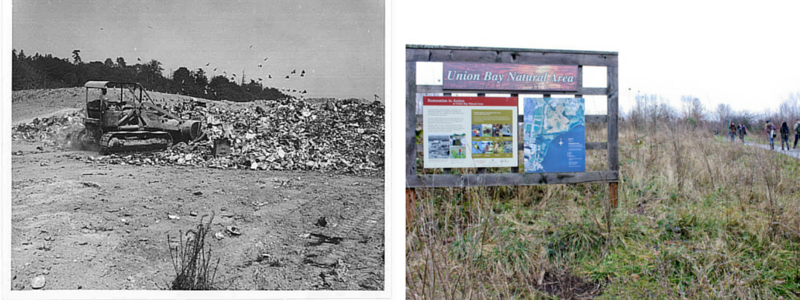
The UW's ENVIR 480: Sustainability Studio class in the Program on the Environment presents students with a sustainability topic which they engage in as part of an experiential learning course. The topics change each quarter - this spring, the students researched the UW's environmental history. This is part of a series of posts by the students on some of the information they uncovered.
The Union Bay Natural Area on the eastern edge of UW's Seattle campus is not only home to wildlife, but also a tranquil place for UW students, faculty and staff to come and actively engage with the local environment. But this wasn’t always the case - up until the mid-20th century, the area was used as a large landfill.
The construction of the Lake Washington Ship Canal in 1916 caused water levels at Union Bay to drop dramatically, creating a swampy marshland prime for garbage. With the new shoreline exposed, developers began making plans for infrastructure in this area. However, with the land too unstable to build anything, the City of Seattle began using the UW property as a public dumpsite in 1926.
For 40 years the Montlake Landfill was used to dump residential and industrial waste, becoming one of the biggest public health concerns in the University District and in the greater Seattle region. Through residential protests and the city’s recognition of the problem, the university closed the landfill in 1966 and began restoring the area the same year.
A layer of clay and soil were spread across the area. Eventually, the ground settled and biotic processes that had long been absent from the land began to take place. Ponds formed from hollows in the soil and willows and cattails sprung up along the water.
Now, the UW Botanic Gardens manages the site and continues to restore the area throughout the year. Invasive species are frequently removed to ensure the biodiversity of native plants and wildlife.
Over 200 species, aquatic and land-dwelling alike, have been observed here over the years. The area is also home to a wide variety of birds, including great blue herons, mergansers, widgeons, and mallards.
UW successfully transformed a hazardous dumpsite into a place both wildlife and people can enjoy. After all, one man's trash is another man's treasure.
By Tiffany Wu, Kevin Terrado, and Ryan Cun
For more information on the environmental history of UW, see our interactive timeline "A Century of Sustainability" at sustainability.uw.edu/timeline
Photos: University of Washington Libraries, Special Collections, UW19075z and Flickr userJarka Gurthova